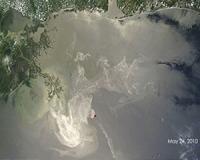 |
Pasadena CA (JPL) May 28, 2010 On May 24, 2010, the Advanced Spaceborne Thermal Emission and Reflection Radiometer (ASTER) instrument on NASA's Terra spacecraft captured this false-color, high-resolution view of the very tip of the Mississippi River delta. Ribbons and patches of oil that have leaked from the Deepwater Horizon well offshore appear silver against the light blue color of the adjacent water. Vegetation is red. In the sunglint region of a satellite image--where the mirror-like reflection of the sun gets blurred into a wide, bright strip--any differences in the texture of the water surface are enhanced. Oil smoothes the water, making it a better "mirror." Oil-covered waters are very bright in this image, but, depending on the viewing conditions (time of day, satellite viewing angle, slick location), oil-covered water may look darker rather than brighter. The relative brightness of the oil from place to place is not necessarily an indication of the amount of oil present. Any oil located near the precise spot where the sun's reflection would appear, if the surface of the Gulf were perfectly smooth and calm, is going to look very bright in these images. The cause of the dark patch of water in the upper left quadrant of the image is unknown. It may indicate the use of chemical dispersants, skimmers or booms, or it may be the result of natural differences in turbidity, salinity or organic matter in the coastal waters. With its 14 spectral bands from the visible to the thermal infrared wavelength region and its high spatial resolution of 15 to 90 meters (about 50 to 300 feet), ASTER images Earth to map and monitor the changing surface of our planet. ASTER is one of five Earth-observing instruments launched December 18, 1999, on NASA's Terra. The instrument was built by Japan's Ministry of Economy, Trade and Industry. A joint U.S./Japan science team is responsible for validation and calibration of the instrument and the data products. The broad spectral coverage and high spectral resolution of ASTER provides scientists in numerous disciplines with critical information for surface mapping and monitoring of dynamic conditions and temporal change. Example applications are: monitoring glacial advances and retreats; monitoring potentially active volcanoes; identifying crop stress; determining cloud morphology and physical properties; wetlands evaluation; thermal pollution monitoring; coral reef degradation; surface temperature mapping of soils and geology; and measuring surface heat balance. The ASTER U.S. science team is located at NASA's Jet Propulsion Laboratory, Pasadena, Calif. The Terra mission is part of NASA's Science Mission Directorate, Washington, D.C.
Share This Article With Planet Earth
Related Links ASTER Earth Observation News - Suppiliers, Technology and Application
 NASA Satellites View Of Gulf Oil Spill Over Time
NASA Satellites View Of Gulf Oil Spill Over TimeWashington DC (SPX) May 28, 2010 Two NASA satellites are capturing images of the oil spill in the Gulf of Mexico, which began April 20, 2010, with the explosion of the Deepwater Horizon oil rig. This series of images reveals a space-based view of the burning oil rig and the ensuing oil spill, through May 24. The imagery comes from the MODIS instruments aboard NASA's Terra and Aqua satellites. The oil slick app ... read more |
|
| The content herein, unless otherwise known to be public domain, are Copyright 1995-2010 - SpaceDaily. AFP and UPI Wire Stories are copyright Agence France-Presse and United Press International. ESA Portal Reports are copyright European Space Agency. All NASA sourced material is public domain. Additional copyrights may apply in whole or part to other bona fide parties. Advertising does not imply endorsement,agreement or approval of any opinions, statements or information provided by SpaceDaily on any Web page published or hosted by SpaceDaily. Privacy Statement |